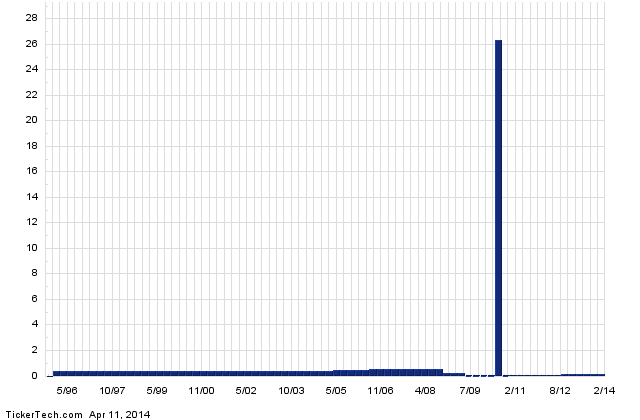Nearly two months after Aubrey McClendon's official resignation, Chesapeake Energy (NYSE: CHK ) has a new CEO.
On Monday, the company confirmed news reports that that its board of directors held a meeting over the weekend and picked Robert Douglas ("Doug") Lawler to replace McClendon as the company's chief executive officer. Lawler is currently the senior vice president for international and deepwater operations�at Anadarko Petroleum� (NYSE: APC ) and will move over to Chesapeake on June 17.
In one sense, it's a move down for Lawler, who at Anadarko ran offshore operations for the second-largest independent oil company in the U.S., which has a $45 billion market cap. But of course, at $14 billion, he will be running the whole show.
Once Lawler takes office on June 17, the interim management structure that Chesapeake set up in March, in which Chairman of the Board Archie W. Dunham, Executive Vice President of Operations and Geosciences Steven C. Dixon, and Chief Operating Officer Domenic J. Dell'Osso Jr., ran the company in lieu of an actual CEO, will dissolve. Their responsibilities will fall to Lawler.
Hot International Stocks To Invest In Right Now: World Energy Solutions Inc(DE)
World Energy Solutions, Inc. provides a range of energy management solutions to commercial and industrial businesses, institutions, utilities, and governments. It offers technology-enabled solutions, such as online audits of facilities to identify retrofit options and project management services for retrofit implementation, as well as cross-selling opportunities for commodity auctions. The company primarily focuses on retail and wholesale energy procurement clients via its online auction platforms, including the World Energy Exchange, the World Green Exchange, and the World DR Exchange. The World Energy Exchange enables energy consumers in North America to negotiate for the purchase or sale of electricity, natural gas, and other energy resources from energy suppliers who have agreed to participate on auction platform. The World Green Exchange enables buyers and sellers to negotiate for the purchase or sale of environmental commodities, such as renewable energy certificates , verified emissions reductions, and certified emissions reductions. The World DR Exchange enables curtailment service providers and energy consumers to negotiate in structured auction events designed to yield price transparency. The company was formerly known as World Energy Exchange, Inc. World Energy Solutions, Inc. was founded in 1996 and is headquartered in Worcester, Massachusetts.
Advisors' Opinion: - [By Rich Duprey]
Farm equipment manufacturer�Deere� (NYSE: DE ) �announced this morning�its second-quarter dividend of $0.51 per share, the same rate it paid last quarter after raising the payout 11%, from $0.46 per share.
Hot International Stocks To Invest In Right Now: Market Vectors Global Alternative Energy ETF (GEX)
Market Vectors-Global Alternative Energy ETF (the Fund) seeks to replicate as closely as possible the price and yield performance of the Ardour Global Index (Extra Liquid) (the Index). The Index, published by Ardour Global Indexes, LLC and calculated by Dow Jones Indexes, is a benchmark for the global alternative energy industry. The Index is a rules-based index that seeks to track the overall performance of a global universe of listed companies engaged in the alternative energy industry. As of April 2007, the Index consisted of publicly traded stocks of 30 of the largest, most actively traded alternative energy companies from worldwide. Companies included in the Index generate over 50% of their revenues from alternative energy and/or related technologies, and are engaged in five core industry sectors: alternative energy resources (solar, wind, bio-fuels, water and geothermal), which constitute approximately 70% of the Index; distributed generation, which constitutes approximately 3% of the Index; environmental technologies related to alternative energy, which constitutes approximately 9% of the Index; energy efficiency, which constitutes approximately 4% of the Index, and enabling technologies, which constitutes approximately 14% of the Index.
The Index consists of the 30 stocks in the Ardour Global Index (Composite) with the highest average of daily trading volume and market capitalization. The Ardour Global Index (Composite) is a modified capitalization-weighted, float-adjusted index comprising publicly traded companies engaged in the production of alternative fuels and/or technologies related to the production of alternative energy power. The Fund will normally invest at least 80% of its total assets in stocks of companies primarily engaged in the business of alternative energy. The Fund, utilizing a passive or indexing investment approach, attempts to approximate the investment performance of the Index by investing in a portfolio of securities that generally replicate the Index. The ! Fund will hold all of the securities, which comprise the Index in proportion to their weightings in the Index. The Fund will normally invest at least 95% of its total assets in securities that comprise the Index. Van Eck Associates Corporation serves as the investment advisor of the Fund.
Advisors' Opinion: - [By Todd Shriber, ETF Professor]
The news was predictably good for a pair of ETFs that should be known as "Tesla ETFs." The Market Vectors Global Alternatve Energy ETF (NYSE: GEX) and the First Trust NASDAQ Clean Edge Green Energy Index Fund (NASDAQ: QCLN) both traded higher on a down day for U.S. stocks, rising to within pennies of their previous 52-week highs.
Brooks Macdonald Group plc is an integrated wealth management group, consists of three principal companies: Brooks Macdonald Asset Management Limited; Brooks Macdonald Financial Consulting Limited, which provides a bespoke, fee based, investment management service to private high net worth individuals, charities and trusts, and also provides in-house custody, nominee and dealing services; Brooks Macdonald Funds Limited, which provides fee-based, independent advice to high net worth individuals, families and businesses, and Brooks Macdonald Financial Consulting Limited, which acts as fund manager to its regulated open ended investment Companies, under the name Brooks Macdonald Funds, as well as providing specialist funds in the property and structured return sectors. It also manages property assets on behalf of the funds and other clients. Its segments include investment management, financial planning, and fund and property management. On July 1, 2012, it acquired JPAM Limited.
Advisors' Opinion: - [By Bob Bogda]
The track record of the annual list is equally as impressive. Since the inaugural edition in 2003, "top stocks" have beaten the market 7 out of 10 years (the jury is still out on the current year). That beats the performance of Warren Buffett's Berkshire Hathaway (NYSE: BRK) by one year during the same span.
- [By David Sterman]
Insurance companies are some of the best deals on the market right now, as many of them still trade below tangible book value. And considering that book value will rise more quickly as interest rates (and interest income) move higher in coming years, Buffett's Berkshire Hathaway (NYSE: BRK) could afford to pay up to 1.25 times book value and still garner excellent long-term returns. Here's a quick list of insurers that fit the bill:
Hot International Stocks To Invest In Right Now: Apollo Group Inc.(APOL)
Apollo Group, Inc., through its subsidiaries, provides online and on-campus educational programs and services at the undergraduate, master?s, and doctoral levels. The company offers various degree programs in arts and sciences, business and management, criminal justice and security, education, health care, human services, nursing, psychology, and technology through its campus locations and learning centers in 40 states and the District of Columbia, and Puerto Rico, as well as through its online education delivery system. It also provides various degree programs in Chile and Mexico, and through online; financial services education programs, including Master of Science in three majors, as well as certification programs in retirement, asset management, and other financial planning areas; and training and education to professionals in the legal and finance industries through its schools in the United Kingdom and a network of offices in Europe. In addition, the company offers p rogram development, administration, and management consulting services comprising degree program design, curriculum development, market research, student admissions, and accounting and administrative services to private colleges and universities for their working learners? programs; and sells books and other publications. Apollo Group, Inc. was founded in 1973 and is based in Phoenix, Arizona.
Advisors' Opinion: - [By Lauren Pollock]
Apollo Group Inc.'s(APOL) fiscal fourth-quarter profit tumbled 71% as the for-profit education company reported a double-digit drop in enrollment at the University of Phoenix. But the company’s shares jumped 19% to $24.93 in premarket trading as results for the period easily topped Wall Street’s expectations.
- [By Holly LaFon]
As for Apollo Education Group (APOL), the situation is different than Centene's in that the For - Profit Education industry is currently experiencing a declining enrollment environment, v ersus the large growth in new members for Medicaid services. However, despite all of the negative news on the education industry in general, and Apollo specifically, we are highly encouraged with APOL's current profit level and its ability to generate abun dant free cash flow.
- [By John Divine]
There's an old Wall Street saying: "Never try to catch a falling knife." While I also try to heed that advice on a day-to-day basis, bearish momentum sure can develop some killer inertia in the stock market. Few investors know this better than Apollo Group (NASDAQ: APOL ) shareholders, as its 2.4% slip today continued its horrific and extended slide. The company that runs the University of Phoenix is facing high dropout rates and the specter of losing its federal funding and accreditation if loan default rates climb.�
- [By Tim Beyers]
Maxims can be the kiss of death in investing. "Always buy low P/E stocks." "Always look for low price-to-book." Holding fast to these supposedly bulletproof investment strategies -- good as they sound -- could cost you, says Fool contributor Tim Beyers in the following video.
The problem is context. A low price-to-earnings multiple is helpful only in those instances where earnings are growing at a faster pace than the low multiple implies. Look at for-profit educator Apollo Group (NASDAQ: APOL ) , which has suffered a single-digit P/E ratio throughout the past year. Revenue and earnings fell consistently over the same period, and the stock is off 50%.
Hot International Stocks To Invest In Right Now: Autodesk Inc.(ADSK)
Autodesk, Inc. provides design software and services to customers worldwide. Its Platform Solutions and Emerging Business segment offers AutoCAD software, a customizable and extensible computer-aided design (CAD) application for professional design, drafting, detailing, and visualization in fields ranging from construction to manufacturing, civil engineering, and process plant design; and AutoCAD LT, a professional drafting and detailing software that includes document sharing capability. The company?s Architecture, Engineering and Construction segment offers Autodesk Revit products, which provide model-based design and documentation system for architects, structural engineers, and design-build teams, as well as mechanical, electrical, and plumbing engineers; AutoCAD Civil 3D products, which provide a surveying, design, analysis, and documentation solution for civil engineering; AutoCAD Architecture software that includes architecture industry-specific tools to improve co ordination; and AutoCAD Map 3D software, which provides direct access to data needed for infrastructure planning, design, and management activities. Autodesk, Inc.?s Manufacturing segment?s products comprise Autodesk Inventor, which offers engineers a set of tools for 3D mechanical design, simulation, analysis, tooling, visualization, and documentation; AutoCAD Mechanical software that accelerates the mechanical design process; and Autodesk Moldflow, which provides tools that help manufacturers optimize the design of plastic parts and injection molds, and study the injection molding process. Its Media and Entertainment segment offers animation products that provide tools for digital sculpting, modeling, animation, effects, rendering, and compositing; and creative finishing products that provide editing, finishing, and visual effects design and color grading. The company also offers design and creation suites. Autodesk, Inc. was founded in 1982 and is headquartered in San R afael, California.
Advisors' Opinion: - [By Benjamin Pimentel]
Shares of Autodesk Inc. (ADSK) �also rallied more than 3% after the design-software company announced Wednesday that it was acquiring Graitec�� Advance Steel and Advance Concrete product lines.
- [By Northrop Puckett]
Autodesk (ADSK), the multinational software company that makes drafting, manufacturing, civil engineering, 3D, and animation design software, has experienced a recent pullback. Part of that is due to the general market correction, but the other part is due to its recent quarterly results. It has pulled back roughly 13% from its high of $41.42 in May. Can it be bought now? Or is there more downside in the stock?
- [By Geoffrey Seiler]
While this transition can lead to lumpy results, the market has embraced other firms that have made this transition, such as Adobe (ADBE) and Autodesk (ADSK).
- [By Markus Aarnio]
Autodesk (ADSK) operates as a design software and services company worldwide. Its Platform Solutions and Emerging Business segment offers AutoCAD software.
Hot International Stocks To Invest In Right Now: eLong Inc.(LONG)
eLong, Inc. operates as an online travel service provider in the People?s Republic of China. The company provides its customers with travel information and the ability to book rooms, air tickets, vacation packages, and other travel related services utilizing call center and Web-based distribution technologies. It facilitates the customers to book rooms in approximately 10,000 hotels in 450 cities across China, and fulfills air ticket reservations in approximately 80 cities across China. In addition, the company offers the ability to book rooms at approximately 100,000 hotels outside of China; and provides the customers informative content relevant to hotel and air travel decisions, including tourist and event site destination information, hotel facility information, and photos. eLong markets its services through online marketing, traditional media advertising, co-marketing with established brands of other companies, and direct marketing. The company was founded in 1999 and is headquartered in Beijing, the People?s Republic of China. eLong, Inc. operates as a subsidiary of Expedia Asia Pacific Limited.
Advisors' Opinion: - [By Seth Jayson]
eLong (Nasdaq: LONG ) reported earnings on May 13. Here are the numbers you need to know.
The 10-second takeaway
For the quarter ended March 31 (Q1), eLong beat expectations on revenues and beat expectations on earnings per share.
- [By Tom Taulli]
Strong Portfolio: Expedia has massive scale, with supply from about 200,000 hotels, 300 airlines and various car rentals and cruise lines. And EXPE sites — which�include Hotwire.com, Hotels.com, CarRentals.com and more, on top of the Expedia namesake — get�about 50 million unique visitors every month. Plus, EXPE also owns a majority stake in eLong (LONG), which is the second largest online travel company in China.
- [By Belinda Cao]
The Bloomberg China-US Equity Index (HSCEI) of the most-traded Chinese stocks in the U.S. added 0.3 percent to 103.21 yesterday. Renren, owner of a real-name social network website, jumped to the highest level since August as volumes surged. Web travel agency Elong Inc. (LONG) soared 20 percent. China Southern Airlines Co. (ZNH), Asia�� biggest carrier by passenger numbers, fell the most in a week and China Eastern Airlines Corp. slid to a three-week low.
- [By Shareholders Unite]
The main on-line competitors are:
Qunar.com, a travel website owned by Baidu (BIDU) and a few venture fundseLong (LONG), backed by Tencent (TCEHY.PK) and Expedia (EXPE). Analyst expect it to generate $163M in revenue next yearThat is pretty serious competition, needless to say. Having the backing of Baidu or Expedia offers several advantages, but Ctrip is the biggest and most established company. It's quite difficult to compare Qunar.com to Ctrip, for the simple sake that Qunar is a private company. However, there can be little doubt that it constitutes serious competition:
Hot International Stocks To Invest In Right Now: Medical Cannabis Payment Solutions (REFG.PK)
Medical Cannabis Payment Solutions, incorporated on December 1, 2005, is a provider of integrated supply and distribution technology. The Company�� Seed-to-Sale (S2S) integrated solution is a management and compliance technology for growers, caregivers and dispensaries in the market. The Company also works with public officials and government agencies to expand the acceptance of medicinal cannabis, and the adoption of a legal framework where maximum market expansion is possible. The Company solves the fragmentation problem by identifying tools that are important to dispensaries, and customizing those tools specifically catered to the industry. The Company's solutions include Spark, Ghost and S2S.
Spark
The Company�� SPARK Hosted Voice over Internet Protocol (VoIP) provides customers with enterprise-class hosted phone systems customized to fit customers��needs. SPARK's service is a fully-managed, cloud-based system. The Company offers the convenience of an online Internet Protocol (IP)-based telecommunications system while still delivering substantial savings to customers bottom line.
Ghost
By offering customers a customized, tailored mobile solution, the Company's Ghost Mobile Apps give a marketing tool with a texting and e-mail solution, keeping customers in constant contact with patients and clients. The Company creates an optimized experience in context to each device or screen size.
Advisors' Opinion: - [By Alan Brochstein]
Not too surprisingly, supply is starting to increase. We have seen some companies enter the space by expanding their own businesses, but there have been some reverse mergers lately too. I had mentioned Refill Energy (REFG.PK) recently (soon to be Medical Cannabis Financial Group), but earlier this month Promap (PMAP.OB) acquired 94% of Advanced Cannabis Solutions (link to 8-K). As an aside, I think that this company is worth considering given the management team and the business model. Investors should keep in the back of their mind that there are many companies that are quietly developing their business models and could become public over time, especially as the regulatory and legal landscapes improve.





 Popular Posts: Health Stocks: Are Premium Grocers and Others Worth a Buy?AMZN: Amazon Stock Has a Big, Boring Problem10 Potential Short Selling Candidates for 2014 Recent Posts: COH: Don’t Try to Catch Flailing Coach Stock Why RSX Is Rebounding After Russia Sanctions Health Stocks: Are Premium Grocers and Others Worth a Buy? View All Posts
Popular Posts: Health Stocks: Are Premium Grocers and Others Worth a Buy?AMZN: Amazon Stock Has a Big, Boring Problem10 Potential Short Selling Candidates for 2014 Recent Posts: COH: Don’t Try to Catch Flailing Coach Stock Why RSX Is Rebounding After Russia Sanctions Health Stocks: Are Premium Grocers and Others Worth a Buy? View All Posts  Unfortunately for handbag and accessory maker Coach (COH) — as well as the embattled holders of Coach stock — the winds of fashion appear to have shifted.
Unfortunately for handbag and accessory maker Coach (COH) — as well as the embattled holders of Coach stock — the winds of fashion appear to have shifted.

 ) reported its first quarter earnings before the opening bell on Friday, posting higher revenues and beating analysts’ earnings estimates.
) reported its first quarter earnings before the opening bell on Friday, posting higher revenues and beating analysts’ earnings estimates.





 Jim West/Alamy Last week, we talked about investing, the second circle of wealth in my series of "Six Absolute Necessities for Acquiring Long-Term Wealth." The third is guaranteed income. When I study people with successful retirements, filled with abundance and options, almost all have things in common: They carry very little, if any, personal debt. They have stable, secure income from multiple sources that they can set their watch by every month Starting about 10 years before they retire, they begin shifting their assets from riskier investments to low- or no-risk income assets. A mortgage is generally the biggest debt most of us have. Many argue that you should never pay off your house because the equity you put into it is tied up and not making you money. They might recommend borrowing as much as you can now because interest rates are low. I say you can have the best of both worlds. First, pay off your mortgage before you retire. By adding small amounts directed to your principle every month, you will take months, even years off your payoff date. When your house is paid off, get the biggest equity line of credit you can. This way, if you see an attractive investment opportunity, you can put your equity to use, and if you don't, you have removed the pressure of a big mortgage payment in retirement. If you can pay off your mortgage while you are working, why not now shift that payment over to a solid savings or income product? This could work out to tens of thousands of extra dollars producing monthly income for when you retire. An abundant retirement is about strong positive cash flow that you can count on for years to come. Do you have any idea how much money you need to retire every month? Do you know where you can get that income from? Do you have enough money for home health care or long-term care? Are you protected from big market downturns during your retirement years? How much will inflation eat into that monthly income needed? Can You Answer These Questions? All these questions must be part of an income plan. We calculate these for clients all over the country. First, know how much income you and your spouse will receive from Social Security when you retire. You can get an estimate from the Social Security Administration. If you believe that number is at risk because of issues with Social Security, you better start putting more away and growing it safely. If you need $5,000 per month to retire and the Social Security for you and your spouse is only $3,500, then you have a $1,500 shortfall. Do you have a pension? How much will that be when you begin to draw it? Do you have a 401(k) or Individual Retirement Account? How long could that account last if you need to draw $1,500 a month -- $18,000 in a year? Will you have to pay taxes on what you take out? If you have a 401(k) or traditional IRA, the answer is yes. If you lose 50 percent of your capital to a bear market, how long will you be able to get $18,000 per year? As you get to be in what we call the "retirement danger zone," which is 10 years before your projected retirement, you need to start shifting assets away from market risk and over to guaranteed products. A solid fixed indexed annuity with a long-term income rider might be a very good call. I wrote an article about the different types of annuities and how to purchase one that fits your needs. A lifetime income rider (state and product variations exist) will guarantee that you have a certain amount of income (depending on how much you have in your annuity and at what age you start withdrawing) for you and your spouse's life. If you live to be very old, your normal retirement funds might run out, but a lifetime income rider guarantees that income stream regardless of what happens to the underlying cash in the account. Also if you have five to 10 years, you have time for that income rider to grow. Many income riders offer 6 percent and more guaranteed growth every year. When you purchase a $200,000 annuity, many companies might offer a 10 percent bonus on your initial purchase price so your starting amount would be $220,000. When you add compound growth at 6 percent over 10 years, your income rider would top $400,000. Then you would start to draw your lifetime income at 6 percent of the $400,000, giving you $24,000 a year income for you and your spouse's life. Presto! You have filled your income gap. If you have the resources to purchase another annuity, you might get one with a cost of living clause to hedge against inflation.
Jim West/Alamy Last week, we talked about investing, the second circle of wealth in my series of "Six Absolute Necessities for Acquiring Long-Term Wealth." The third is guaranteed income. When I study people with successful retirements, filled with abundance and options, almost all have things in common: They carry very little, if any, personal debt. They have stable, secure income from multiple sources that they can set their watch by every month Starting about 10 years before they retire, they begin shifting their assets from riskier investments to low- or no-risk income assets. A mortgage is generally the biggest debt most of us have. Many argue that you should never pay off your house because the equity you put into it is tied up and not making you money. They might recommend borrowing as much as you can now because interest rates are low. I say you can have the best of both worlds. First, pay off your mortgage before you retire. By adding small amounts directed to your principle every month, you will take months, even years off your payoff date. When your house is paid off, get the biggest equity line of credit you can. This way, if you see an attractive investment opportunity, you can put your equity to use, and if you don't, you have removed the pressure of a big mortgage payment in retirement. If you can pay off your mortgage while you are working, why not now shift that payment over to a solid savings or income product? This could work out to tens of thousands of extra dollars producing monthly income for when you retire. An abundant retirement is about strong positive cash flow that you can count on for years to come. Do you have any idea how much money you need to retire every month? Do you know where you can get that income from? Do you have enough money for home health care or long-term care? Are you protected from big market downturns during your retirement years? How much will inflation eat into that monthly income needed? Can You Answer These Questions? All these questions must be part of an income plan. We calculate these for clients all over the country. First, know how much income you and your spouse will receive from Social Security when you retire. You can get an estimate from the Social Security Administration. If you believe that number is at risk because of issues with Social Security, you better start putting more away and growing it safely. If you need $5,000 per month to retire and the Social Security for you and your spouse is only $3,500, then you have a $1,500 shortfall. Do you have a pension? How much will that be when you begin to draw it? Do you have a 401(k) or Individual Retirement Account? How long could that account last if you need to draw $1,500 a month -- $18,000 in a year? Will you have to pay taxes on what you take out? If you have a 401(k) or traditional IRA, the answer is yes. If you lose 50 percent of your capital to a bear market, how long will you be able to get $18,000 per year? As you get to be in what we call the "retirement danger zone," which is 10 years before your projected retirement, you need to start shifting assets away from market risk and over to guaranteed products. A solid fixed indexed annuity with a long-term income rider might be a very good call. I wrote an article about the different types of annuities and how to purchase one that fits your needs. A lifetime income rider (state and product variations exist) will guarantee that you have a certain amount of income (depending on how much you have in your annuity and at what age you start withdrawing) for you and your spouse's life. If you live to be very old, your normal retirement funds might run out, but a lifetime income rider guarantees that income stream regardless of what happens to the underlying cash in the account. Also if you have five to 10 years, you have time for that income rider to grow. Many income riders offer 6 percent and more guaranteed growth every year. When you purchase a $200,000 annuity, many companies might offer a 10 percent bonus on your initial purchase price so your starting amount would be $220,000. When you add compound growth at 6 percent over 10 years, your income rider would top $400,000. Then you would start to draw your lifetime income at 6 percent of the $400,000, giving you $24,000 a year income for you and your spouse's life. Presto! You have filled your income gap. If you have the resources to purchase another annuity, you might get one with a cost of living clause to hedge against inflation.
